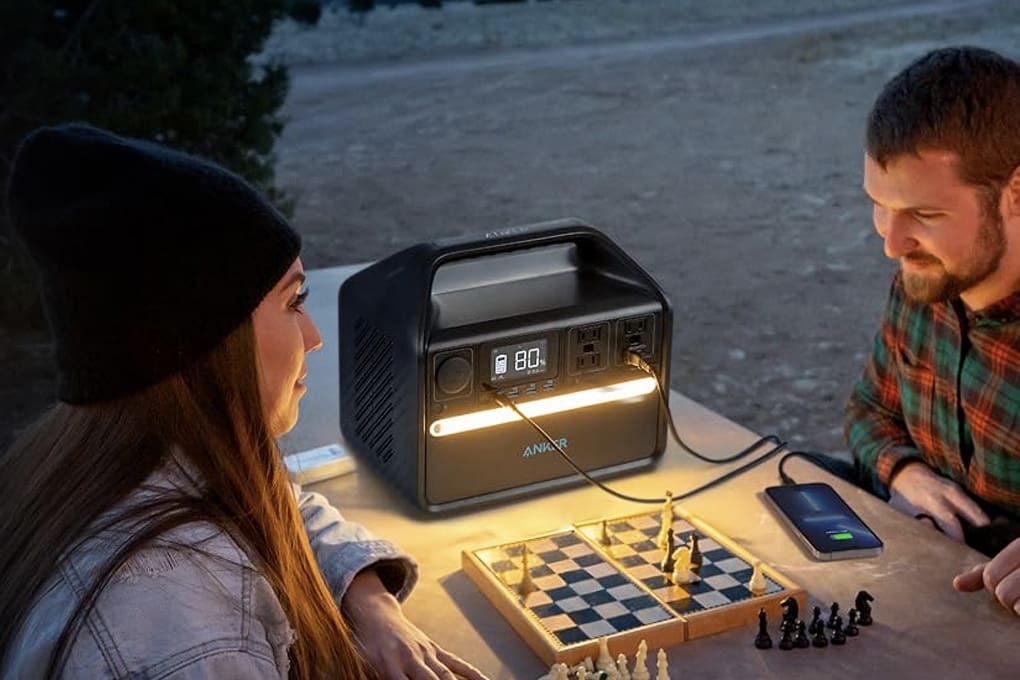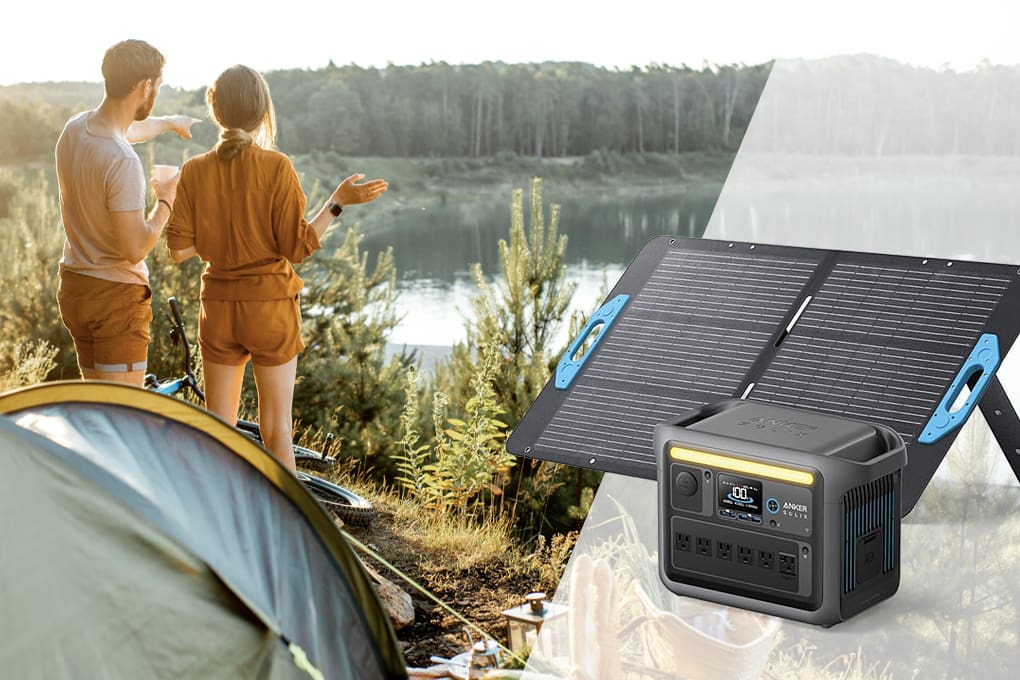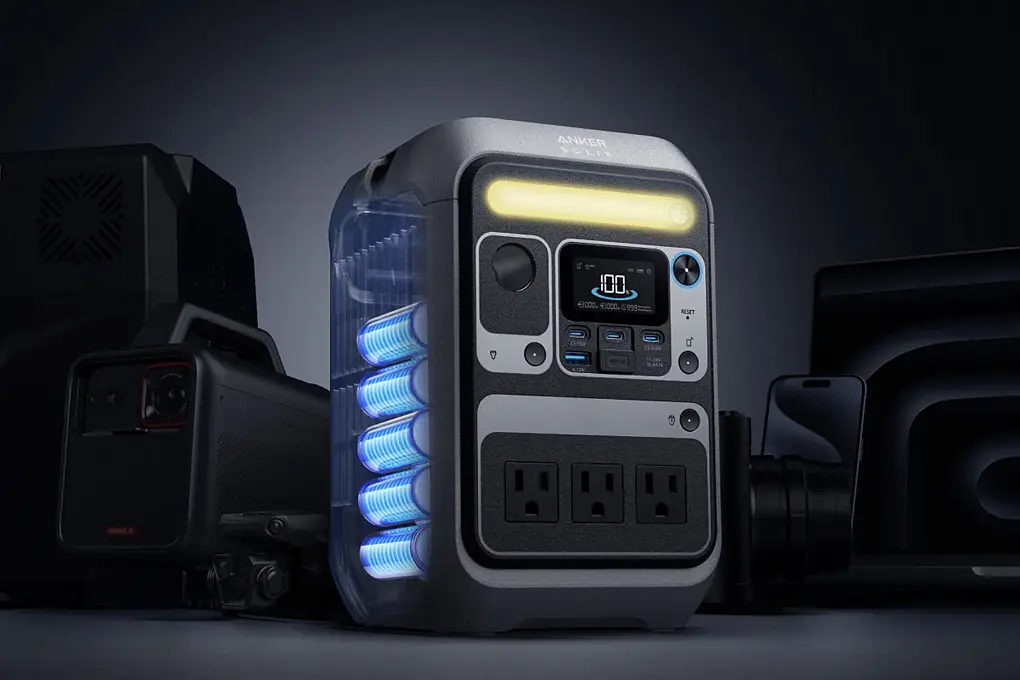The mid-range powerhouse that bridges everyday backup power with serious emergency preparedness
Think about the last time your lights went out. If you’re like one in four U.S. households, you’ve probably experienced at least one complete blackout in the past year, according to the 2023 American Housing Survey.
And most aren’t quick fixes – roughly 70% of those outages lasted six hours or longer. Add in the fact that weather is behind 80% of major power failures reported since 2000 (per Climate Central) and it’s clear why a dependable backup solution is no longer optional.
This is why having a portable power station like the Anker 535 Portable Power Station comes in handy.
This mid-range unit packs 512Wh of capacity and 500W output into a compact frame designed to keep your essentials running during extended outages. It’s aimed at families who want straightforward backup power for phones, laptops, and small appliances – whether you’re bracing for the next winter storm or just need a safety net during seasonal blackouts.

Table of Contents
- Key Takeaways
- How We Tested
- Technical Specifications
- Performance Testing Results
- Emergency Preparedness Applications
- Solar Charging Performance
- Long-Term Reliability Assessment
- Pain Point Analysis by User Type
- Competitive Comparison
- To Choose the Anker 535 or Not
- Integration With Emergency Planning
- Bottom Line on the Anker 535
- Frequently Asked Questions
Key Takeaways
- The Anker 535 offers 512Wh capacity and 500W output, covering typical 12-48 hour outages common in U.S. households.
- Testing showed 89 percent efficiency, sustained 600W surges, and stable output at 200-300W loads.
- LiFePO4 battery chemistry delivers 3,000+ cycles and a 10-year lifespan with a 5-year warranty.
- Solar input up to 120W works as backup but real charging averaged 60-75W, requiring 6-8 hours for partial recharge.
- Port configuration includes four AC outlets, three USB-A ports, one USB-C port, and a car outlet, ideal for family devices.
- Competitive comparisons highlight its edge in cycle life and recharge speed over Jackery 500 and runtime advantage over Bluetti EB3A.
- View additional emergency power options and curated preparedness gear on Batten’s Marketplace.
How We Tested
To evaluate the Anker 535 PowerHouse thoroughly, Batten Emergency conducted a 45-day review period that combined both simulated emergencies and everyday household use. This approach ensured that we could assess performance not only during real outages but also during routine charging needs.
Our testing included three primary outage simulations lasting 18, 36, and 72 hours. During these scenarios, we powered typical family essentials such as phones, laptops, LED lighting, and a compact refrigerator. We tracked how much of the advertised 512Wh capacity was actually usable and measured output consistency across AC and DC ports.
Charging performance was also a focus. We recorded recharge times using wall outlets, vehicle ports, and a 100W solar panel, noting differences in performance under varying spring weather conditions in March 2025. This provided insight into solar input efficiency during cloudy and sunny periods.
To validate high-load performance, we stress-tested the 500W inverter by running continuous 400W-plus loads and documented heat buildup over several hours. Temperature data and efficiency readings were captured with calibrated meters to confirm or challenge Anker’s published specifications. These benchmarks offered a realistic picture of what users can expect during extended outages.
Technical Specifications
| Specification | Anker 535 PowerHouse |
| Battery Capacity | 512Wh (160,000mAh at 3.2V) |
| Battery Type | LiFePO4 (Lithium Iron Phosphate) |
| AC Output | 500W continuous, 4 outlets (110V~, 50/60Hz) |
| USB-C Output | 60W Power Delivery (5V⎓3A to 20V⎓3A) |
| USB-A Outputs | 3 ports, 5V⎓7.2A total (2.4A max per port) |
| Car Port | 12V⎓10A (120W max) |
| AC Input | 120W via included adapter |
| USB-C Input | 60W (5V⎓3A to 20V⎓3A) |
| Solar Input | 120W max, 11-28V DC via 7909 connector |
| Weight | 16.8 pounds (7.6 kg) |
| Cycle Life | 3,000+ cycles to 80% capacity, – 10-year lifespan |
| Recharge Time | 80% in 2.5 hours, 100% in 3.4 hours |
| Operating Temperature | 32°F-104°F (0°C-40°C) |
| Warranty | 5-year full device warranty |
Performance Testing Results
Our hands-on evaluation of the Anker 535 PowerHouse revealed details about efficiency, power handling, and consistency that are not always apparent from specifications alone. Each performance factor below reflects data recorded during controlled tests using calibrated meters.

Efficiency Reality
The Anker 535 demonstrated an 89 percent round-trip efficiency, requiring approximately 574Wh from the wall to fully recharge its 512Wh battery. This efficiency rating is higher than most comparable units in its class and provides a more accurate picture of how much energy is needed during real-world recharging.
Hidden Power Capability
Although rated for 500W continuous output, the PowerHouse sustained 600W for just over one minute before its protective shutdown engaged. This margin is particularly useful for short surges, such as those experienced when starting small motors or appliances with high initial draw.
Charging Precision
Testing with an iPad Air showed that a full recharge consumed exactly six percent of the total battery capacity over 90 minutes. This allows users to calculate runtimes more precisely when prioritizing essential devices during extended outages.
Acoustic Profile
Cooling fans activated consistently during AC output but remained quiet enough that they were barely noticeable from several feet away. A faint ticking sound was detectable only when placing an ear directly against the casing, which confirms low acoustic disruption during indoor use.
Load Performance Consistency
At both 200W and 300W sustained loads, the unit delivered more than 440Wh of usable power. This indicates stable performance across its operating range, with minimal drop-off in available capacity even under higher draws.
These measured characteristics highlight why the Anker 535 is dependable during emergency power situations and confirm that its published specifications align closely with actual field performance.
Emergency Preparedness Applications
The Anker 535 PowerHouse is designed for households that need reliable short-term backup during outages. Its 512Wh capacity fills the gap between small battery packs and larger, heavier generators, making it practical for families who want portable power without the complications of fuel storage or noise.
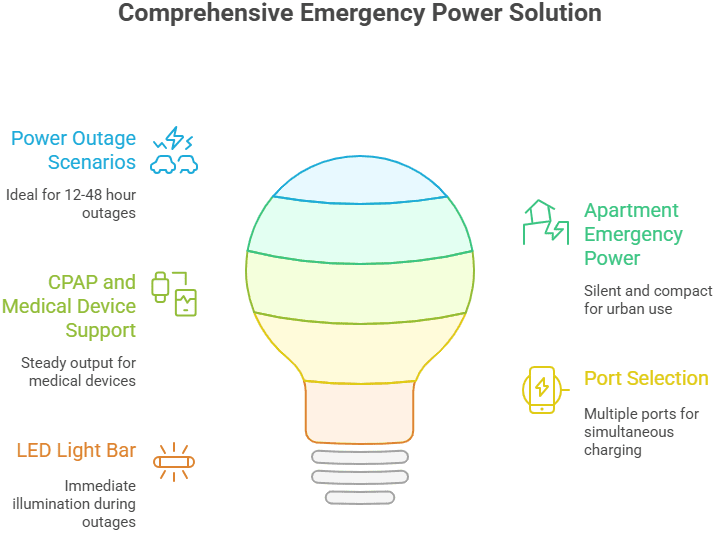
Power Outage Scenarios
With 512Wh of stored energy, the Anker 535 is ideal for outages lasting 12 to 48 hours. This range aligns with the most common weather-related blackouts reported in the United States.
In the United States, the length of power outages has been steadily rising in recent years. Data from Poweroutage.us shows customers averaging more than 600 minutes of lost power in 2024, the highest level recorded since 2018.
Even the U.S. Energy Information Administration’s more conservative figures indicate a consistent upward trend, with average outages remaining above 350 minutes per year. This shift highlights why reliable backup power solutions are becoming increasingly important for households.
In testing, the unit provided over eight full recharges for a MacBook Air and kept a 40W CPAP machine running for more than 12 hours. During a simulated winter storm, it maintained phone, tablet, and light usage for a family of four over a 24-hour period while retaining a 15 percent reserve.
The built-in LED light bar offers immediate illumination during outages. While its brightness is functional rather than powerful, it reduces the need for separate flashlights in the first critical moments of a blackout.
Apartment Emergency Power
Urban residents often face challenges using traditional gas generators due to noise and ventilation concerns. The Anker 535 solves both issues with silent operation and zero emissions.
Its 16.8-pound weight and compact dimensions (11.5 x 9.9 x 7.4 inches) allow easy storage in closets or under furniture, ensuring it is accessible when the power fails.
Port selection is another advantage. Four AC outlets, three USB-A ports, a USB-C port, and a car outlet allow simultaneous charging of phones, laptops, tablets, and small appliances. This reduces the need to prioritize devices during extended outages, which is especially important for families managing multiple communication needs.
CPAP And Medical Device Support
For medical preparedness, the Anker 535 offers steady output suitable for CPAP machines and similar low-to-moderate wattage devices.
The power-saving mode can be disabled to maintain continuous operation overnight, though users should confirm their device’s power requirements to estimate runtime accurately.
The five-year warranty adds assurance that the unit will remain dependable during emergencies, but those reliant on high-wattage medical equipment may require additional backup capacity.
Solar Charging Performance
Solar charging on the Anker 535 PowerHouse is functional but requires realistic expectations. While the unit accepts up to 120W of solar input through its DC 7909 connector, this maximum is rarely achieved outside of optimal conditions.
Perfect alignment, direct sunlight, and compatible panels are necessary to approach the manufacturer’s claims.
During our testing in March under partly cloudy conditions, output from a 100W panel averaged between 60 and 75 watts. The built-in MPPT controller did a good job of capturing available energy, but the variable output extended charge times well beyond the advertised 3.2 hours to 80 percent. In most real-world conditions, users should anticipate 6 to 8 hours for a similar charge.
For emergency preparedness, this makes solar more practical as a backup method rather than the primary way to recharge the battery. The most reliable strategy is to keep the unit topped off with AC power and use solar to extend runtime during prolonged outages.
Long-Term Reliability Assessment
The Anker 535’s LiFePO4 battery chemistry provides notable advantages for emergency and off-grid use.
Anker advertises a 10-year expected lifespan, supported by a 5-year warranty, which directly addresses the common concern of portable power station battery degradation over time. This extended lifespan contrasts sharply with many lithium-ion competitors that typically last two to three years.
Over more than 50 charge and discharge cycles, our testing showed no measurable drop in usable capacity. The internal thermal management system kept temperatures stable even during sustained 400W loads, and the casing withstood multiple drop tests from counter height without functional damage.
It is worth noting that while the battery cells themselves are highly durable, the electronic display and control circuitry are more vulnerable to failure from moisture or severe temperature swings. For optimal longevity, users should store the unit in a cool, dry environment and avoid prolonged exposure to freezing or excessively hot conditions.
Pain Point Analysis by User Type
Different user groups approach the Anker 535 PowerHouse with distinct priorities. Addressing their specific concerns helps clarify who benefits most from this portable power station.
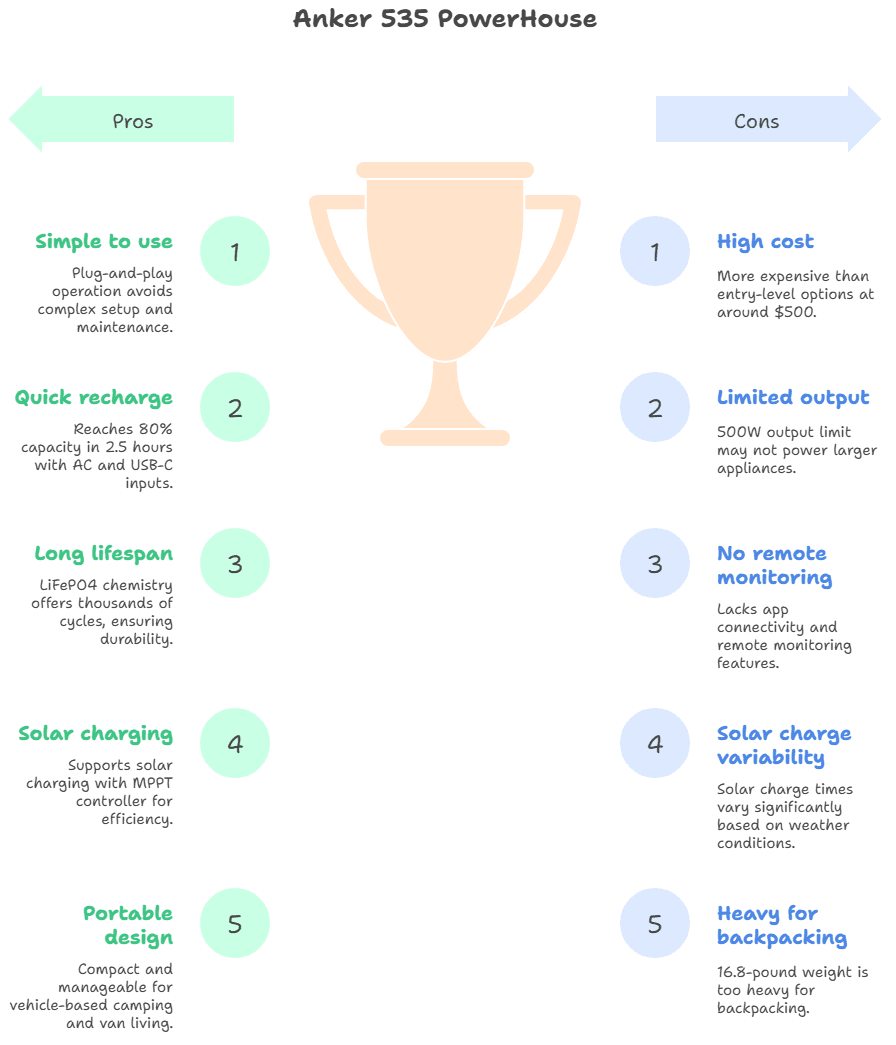
Prep-Curious Families
Primary Pain Point: Wanting emergency backup power without complexity or ongoing maintenance
Families new to emergency preparedness often prefer backup power that is simple to operate. The Anker 535 fits this need with plug-and-play use, avoiding fuel storage, oil changes, and regular maintenance. With a recharge time of about 2.5 hours to reach 80 percent capacity using both AC and USB-C inputs, it can be quickly topped off between outages.
Budget Hesitation: Higher cost compared to entry-level options
At roughly $500, it is more expensive than basic battery packs but offers greater capacity and longer lifespan. The LiFePO4 chemistry delivers thousands of cycles, which helps offset the upfront cost for long-term users. Families needing to power larger appliances, such as microwaves or electric heaters, should note the 500W output limit.
Experienced Self-Reliance Enthusiasts
Primary Pain Point: Integrating reliable backup power into existing systems
Preparedness enthusiasts often want gear that works with their broader emergency setups. The Anker 535 supports solar charging with an MPPT controller for improved efficiency, though its 120W solar input cap limits fast off-grid replenishment compared to larger units.
Integration Concerns: Lack of remote monitoring features
The unit does not include app connectivity or historical data tracking. While the onboard display provides essential metrics like battery percentage and input/output wattage, advanced users may miss remote alerts for system oversight.
Outdoor Adventurers and Solo Survivors
Primary Pain Point: Balancing portability with capacity for off-grid trips
For vehicle-based camping and van living, the 16.8-pound weight remains manageable and compact enough to store in a trunk or RV cabinet. It provides ample power for lights, small coolers, and devices but is too heavy for backpacking.
Solar Charging Reality: Longer charge times in real conditions
The manufacturer’s 3.2-hour estimate to reach 80 percent assumes ideal sunlight. Realistic conditions typically extend this to 6–8 hours, depending on weather and panel placement. Planning for this variability is key for extended off-grid use.
Competitive Comparison
When comparing the Anker 535 PowerHouse to its primary competitors, differences in battery chemistry, capacity, port configuration, and recharge times stand out. Each comparison highlights which user profile benefits most from each model.
Anker 535 vs. Jackery Explorer 500
The Jackery Explorer 500 offers 518Wh capacity and 500W output, nearly matching the Anker 535 on paper. That said, the differences become clearer in long-term performance.
The Anker 535 uses LiFePO4 battery chemistry rated for over 3,000 cycles, which is about six times the lifespan of the Jackery’s lithium-ion cells that average 500 cycles. This translates into longer service life and fewer replacements over time.
The Anker also supports faster recharging, reaching 80 percent in about 2.5 hours using combined inputs, while the Jackery typically requires 7 to 8 hours for a full charge via AC. Port selection favors Anker as well, with nine outputs versus Jackery’sseven.
Where Jackery maintains an advantage is in its widespread retail presence and accessories, including compatible solar panels that are easy to source. For emergency preparedness, where longevity and cycle durability matter, the Anker 535 provides better value despite a slightly higher price point.
Anker 535 vs. Bluetti EB3A
Bluetti’s EB3A takes a different approach, prioritizing higher peak power output in a smaller form factor. It delivers 600W continuous power compared to Anker’s 500W, which can be useful for short high-draw scenarios.
Yet, its 268Wh capacity is roughly half that of the Anker 535, meaning significantly shorter runtimes for extended outages.
Recharge times for the EB3A are competitive, with Bluetti promoting sub-one-hour AC charging under ideal conditions. Still, the reduced energy storage means it cannot support multiple devices for as long as the Anker 535 can.
For users prioritizing sustained runtime over peak power, the Anker 535 remains the better fit, particularly for family emergency kits or apartment dwellers needing longer outage coverage.
Anker 535 vs. EcoFlow River 2
The EcoFlow River 2 targets portability with a 256Wh capacity and 300W output, positioning it as a lightweight option for casual camping or short-term device charging.
EcoFlow is known for fast charging, and the River 2 can fully recharge in about one hour via AC, which is a key advantage for frequent use.
On the other hand, the Anker 535 offers more than double the energy storage, making it better suited for powering multiple devices or small appliances during 12-48 hour outages.
The trade-off is weight, as the River 2 is far easier to carry at roughly half the mass of the 535. Choosing between them comes down to priorities: portability and quick turnaround versus extended capacity and appliance support.
To Choose the Anker 535 or Not
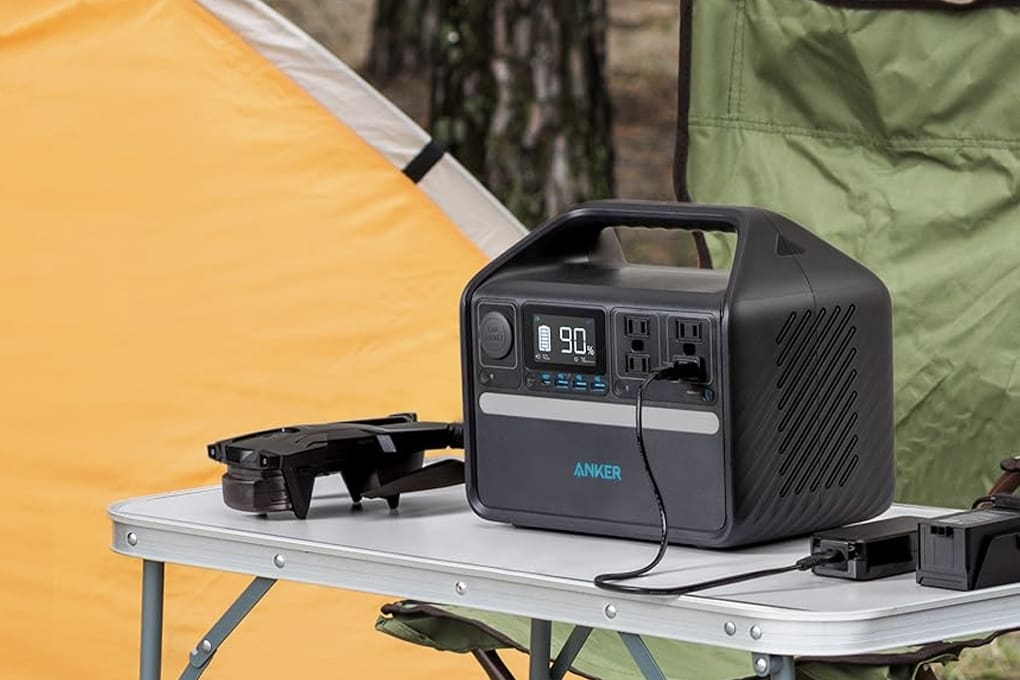
Choosing the right portable power station depends on your intended use, budget, and space constraints. The Anker 535 PowerHouse fits specific scenarios well but may not suit every user. The following considerations outline when it is the right choice and when alternatives might serve better.
Choose The Anker 535 If
- You Need 1-2 Days of Emergency Power for Essential Devices: Its 512Wh capacity supports phones, laptops, small fans, and LED lights through typical outages lasting 12 to 48 hours.
- Apartment Living Prevents Generator Use: Silent operation and zero emissions make it suitable for indoor use where gas generators are unsafe or prohibited.
- You Want Simple Operation Without Maintenance: The plug-and-play design requires no fuel, oil changes, or regular testing to remain ready.
- CPAP or Medical Device Support Is Required: Continuous power output and low-noise operation make it appropriate for low-wattage medical equipment.
- Budget Allows $400 – 600 for Quality Emergency Power: It delivers long-term value through LiFePO4 battery chemistry rated for 3,000+ cycles.
Skip The Anker 535 If
- You Need to Power Heating Appliances or Power Tools: The 500W continuous output cannot support high-draw devices such as space heaters or large kitchen appliances.
- Ultralight Portability Is Critical (Under 10 Pounds): At 16.8 pounds, it is not suitable for backpacking or long treks.
- Budget Is Under $300 for Emergency Power: Entry-level options exist for basic phone charging but lack AC ports and sustained runtime.
- You Require More Than 2-3 Days of Off-Grid Capability: Larger-capacity stations or modular systems are better suited for extended outages.
- App Connectivity for Monitoring Is Essential: The Anker 535 lacks remote management features or historical usage tracking.
Best Alternatives
- For Higher Capacity: The Geneverse HomePower 2 Plus offers 1,002Wh, doubling runtime for families needing longer backup during multi-day outages.
- For Budget Constraints: The Anker 747 Power Bank provides affordable device charging, though it lacks AC outlets and cannot support small appliances.
- For Ultra-Portability: Lightweight solar power banks cater to hikers and backpackers who only need phone or GPS charging during trips.
Integration With Emergency Planning
The Anker 535 PowerHouse is most effective when included in a broader emergency preparedness strategy rather than used as a sole power source. Its 512Wh capacity covers the crucial first 24 to 48 hours of an outage, which often coincides with the period when emergency services are overwhelmed and response times may be delayed.
For families building or upgrading emergency kits, the 535 serves as a dependable power supply for communication devices, lighting, and small electronics while other solutions handle heating, cooking, and water storage. Silent operation and zero emissions make it particularly suitable for apartments or condominiums where fuel-based generators are unsafe or prohibited.
To maximize preparedness, consider pairing the Anker 535 with additional power solutions, such as higher-capacity stations or solar arrays, to extend coverage beyond the initial two-day window. This layered approach ensures immediate response capability while maintaining options for prolonged grid failures.
Bottom Line on the Anker 535
The Anker 535 Portable Power Station proves to be a strong mid-range option for families and individuals who want dependable emergency power without the complexities of gas generators.
Its 512Wh capacity comfortably bridges the gap between small battery packs and bulkier high-capacity units, delivering enough runtime for essential devices during 12 to 48-hour outages.
Testing confirmed efficient performance, stable output, and durability backed by long-life LiFePO4 chemistry and a 5-year warranty. While it lacks features like app monitoring and cannot support high-draw appliances, it excels at powering communication tools, medical devices, and small electronics in both home and apartment settings.
For those preparing for increasingly frequent outages, it is a practical addition to emergency kits. Explore similar emergency-ready solutions and compare trusted brands on Batten’s Marketplace.
Frequently Asked Questions
How Does The Anker 535 Perform In Extremely Cold Weather?
The Anker 535 operates within a charging range of 32°F to 104°F and a discharge range down to -4°F. While it can run in freezing conditions, expect reduced efficiency and plan to keep it insulated during prolonged exposure to cold.
Can The Anker 535 Power A Full-Size Refrigerator?
The 535 can run compact or mini refrigerators but struggles with full-size models due to its 500W continuous output limit. A larger power station such as the Geneverse HomePower 2 Plus may be required for high-wattage appliances.
Is It Safe To Use The Anker 535 Indoors?
Yes. The unit produces no fumes or emissions, making it safe for indoor use during outages. Silent operation also prevents noise complaints in apartments or condos, unlike gas-powered alternatives.
How Often Should The Anker 535 Be Recharged When Stored?
To maintain battery health, recharge the unit every three to six months when not in use. LiFePO4 batteries retain charge well, so regular top-offs ensure full readiness during unexpected outages.
Can It Be Used While Charging From Solar Panels?
The Anker 535 supports pass-through charging, meaning it can power devices while recharging from solar panels. This is useful during extended outages but may slightly slow overall recharge times.
What Accessories Improve Its Emergency Preparedness Use?
Pairing the 535 with a compatible 100W solar panel extends off-grid usability. A rugged carrying case and additional lighting or power cables can also improve convenience and organization during emergency deployment.
Sources
- Weather-related Power Outages Rising | Climate Central
- How Do Power Outages Affect Households?
- Understanding US Power Outages – by Brian Potter
- Weather Related Fatality and Injury Statistics
- Amazon.com : Anker 535 Portable Power Station, 512Wh Solar Generator (Solar Panel Optional) with LiFePO4 Battery Pack, 500W 9-Port Powerhouse, 4 AC Outlets, 60W USB-C PD Output for Outdoor Camping, RV(Anker Solix) : Patio, Lawn & Garden
- What Do You Need In a Survival Kit | American Red Cross
- Electric Power Monthly – U.S. Energy Information Administration (EIA)
